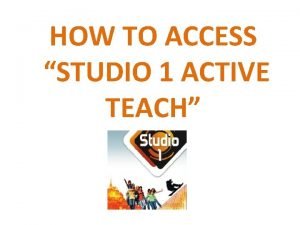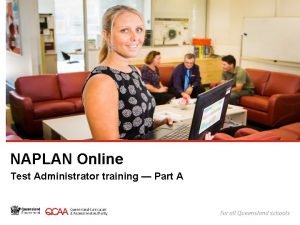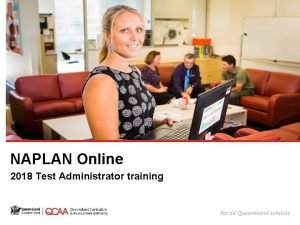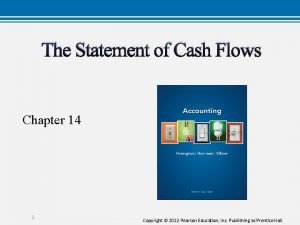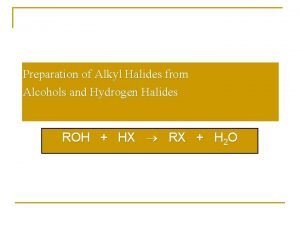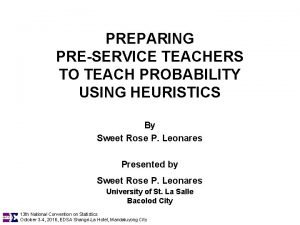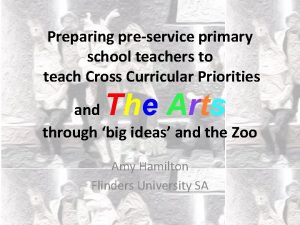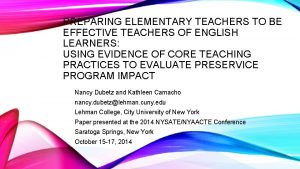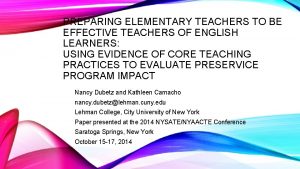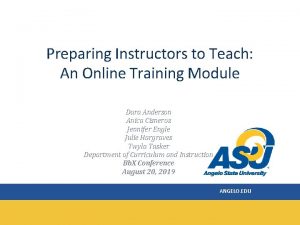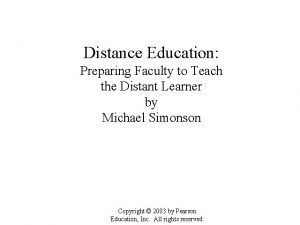Preparing Physical Education Teachers to Teach Online A














- Slides: 14

Preparing Physical Education Teachers to Teach Online… A Cautionary Tale David N. Daum – University of Southern Indiana Craig A. Buschner – California State University - Chico

Overview • Prevalence of online education • What we know of online physical education • Group discussion • Reflection

Prevalence • 2004 -2005, 700, 000 K-12 students enrolled in online courses (Picciano & Seaman, 2007) • 2009 -2010, 1. 5 million K-12 students enrolled in online courses (Wicks, 2010)

Keeping Pace with K-12 Online Learning (2012) • Online or hybrid learning opportunities for students in all 50 states • Single district programs are the fastest growing option for online and hybrid • Hybrid is more common than fully online • 40 states have state level virtual school initiatives • Move towards the “Common Core” • 200, 000 K-12 students enrolled in full time online schools

Shape of the Nation (2006, 2010) • 2006 – 12 (24%) of states allow required physical education credits to be earned online • 2010 – 22 (43%) states ▫ 6 states offer comprehensive physical education, defined as addressing all state or national standards ▫ 10 require courses to be taught by state certified P. E. teachers

Shape of the Nation 2012 • 30 states (60%) ▫ 17 require courses to be taught by state certified P. E. teachers

Initial Guidelines for Online Physical Education (2007) • “No published evidence of learning in physical education” regarding learning in online physical education. • Hybrid model is advocated by NASPE because it is the “reasonable instructional alternative for this subject matter until further research is available” • “At this point in time, online physical education is an exciting and attractive, yet untested, alternative to delivering quality physical education”

K-12 OLPE in the U. S. • Some online physical education courses have no physical activity (Daum & Buschner, 2012) • Most online physical education courses are cognitive and fitness focused (Daum & Buschner, 2012) • 10% of the over 150, 000 course completions at Florida Virtual School were physical education courses (Mosier, 2010) • Online physical education students showed similar satisfaction and increased physical performance compared to traditional students (Futrell, 2009)

Group Discussion • Each table has a moderator • Approximately 15 min. Discussion • Focus on secondary OLPE • 2 -3 min. report back to the group

Moderators • Dr. Josh Trout – California State University - Chico • Dr. Kevin Patton – California State University - Chico • Dr. Jesse Rhoades – University of North Dakota • John Mercer – University of Illinois at Urbana. Champaign • Chris Gentry - University of Illinois at Urbana. Champaign

The “Cautionary Tale” • Go in with “open” eyes • Caveats everywhere with regard to online learning • We can’t predict the future, but we need to work proactively • Disconnect between teacher training and what is happening in the field? • Effectiveness of online learning appears broad across content and learner types (DOE, 2010)

The “Cautionary Tale” • Limited published data regarding OLPE to inform practice ▫ Most research conducted in medicine, military, and higher education (DOE, 2012) • 44% of students did not find the discussion components helpful (Kim, Kim & Karimi, 2012) • Should we listen to people outside the field of physical education regarding OLPE?

Discussion Questions • Are your pre-service teachers prepared to design and teach online physical education programs at the secondary level? If so, how did you prepare them for this new mode of teaching? If not, what do you think they need to learn (three critical components) to be effective online teachers? • How would secondary online physical education meet the NASPE Standards (2004)? Assuming that the cognitive domain (Standard 2) could be met online, how would the psychomotor (Standard 1) and affective (Standard 5) domains be taught using a hybrid or fully online physical education model? • Do you (PETE faculty) have the knowledge and skill to educate future secondary teachers for online physical education teaching? Do your PETE faculty colleagues have this knowledge and skill? If yes, how did you acquire these competencies? If no, what do you need to know?

Discussion Questions • Much like the series of descriptive studies titled “What’s going on in the Gym? ” (Anderson & Barrette, 1978) we believe something similar needs to happen with online physical education. In order to answer the most salient issues regarding online physical education what discussions must take place? What research questions warrant investigation? • How does a PETE faculty incorporate online physical education content and pedagogy into an already packed physical education majors’ curriculum? Would you include online physical education pedagogy into its own course or include it in existing courses? If existing courses, what course(s) would best serve online physical education content and pedagogy? • We are the only subject matter where motor activity and fitness is addressed at the secondary level. In other words, should physical education be the one school subject in the student’s education that minimizes screen time? Should we educate pre-service teachers to defend against secondary online physical education in favor of face-to-face P. E. ?
 Kim kroll teachers pay teachers
Kim kroll teachers pay teachers Active teach online
Active teach online Differences between health education and health promotion
Differences between health education and health promotion Naplan locked down browser
Naplan locked down browser Naplan online test administration handbook for teachers
Naplan online test administration handbook for teachers National association of special education teachers
National association of special education teachers Mise en place sandwiches
Mise en place sandwiches Statement of cash flows partial
Statement of cash flows partial Preparing for research design
Preparing for research design When preparing an iv solution a technician should work
When preparing an iv solution a technician should work How might a valet satisfy a valet-serviced guest?
How might a valet satisfy a valet-serviced guest? Preparing for revival
Preparing for revival How to select and prepare sweet sauces for desserts
How to select and prepare sweet sauces for desserts Hydrogen halide
Hydrogen halide What is the formula of molarity
What is the formula of molarity

